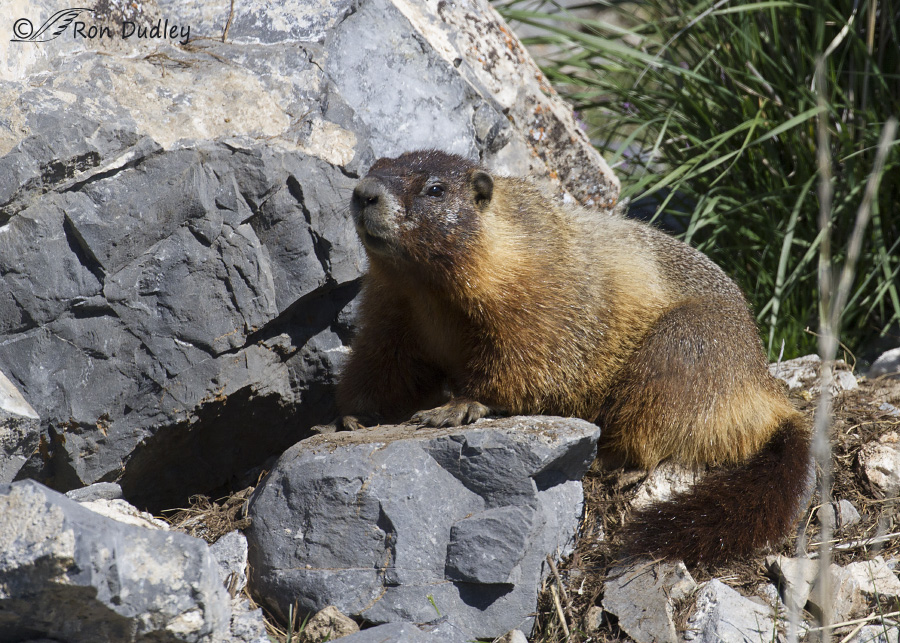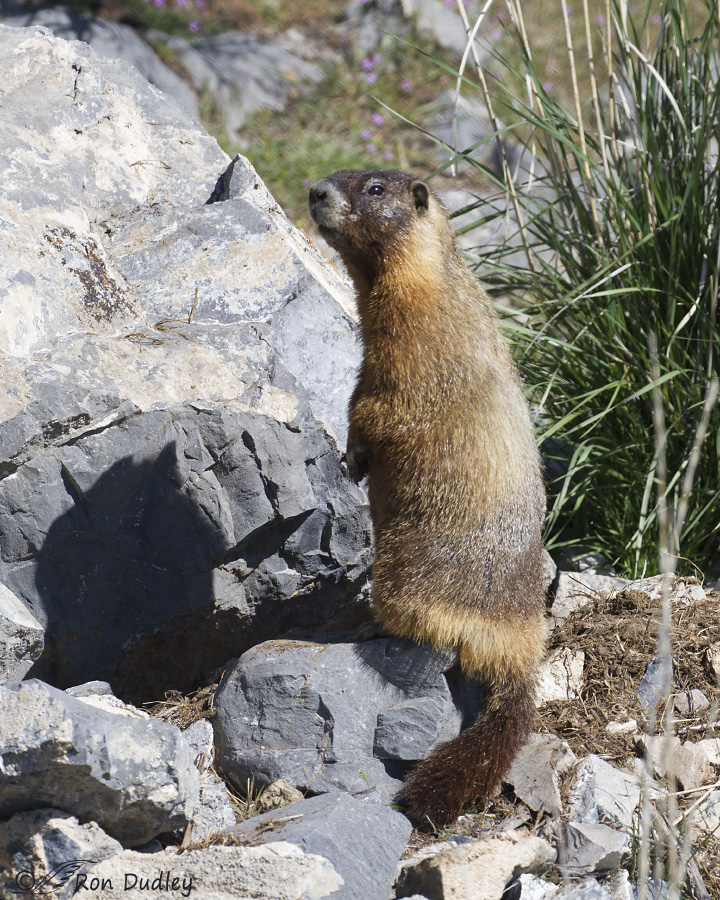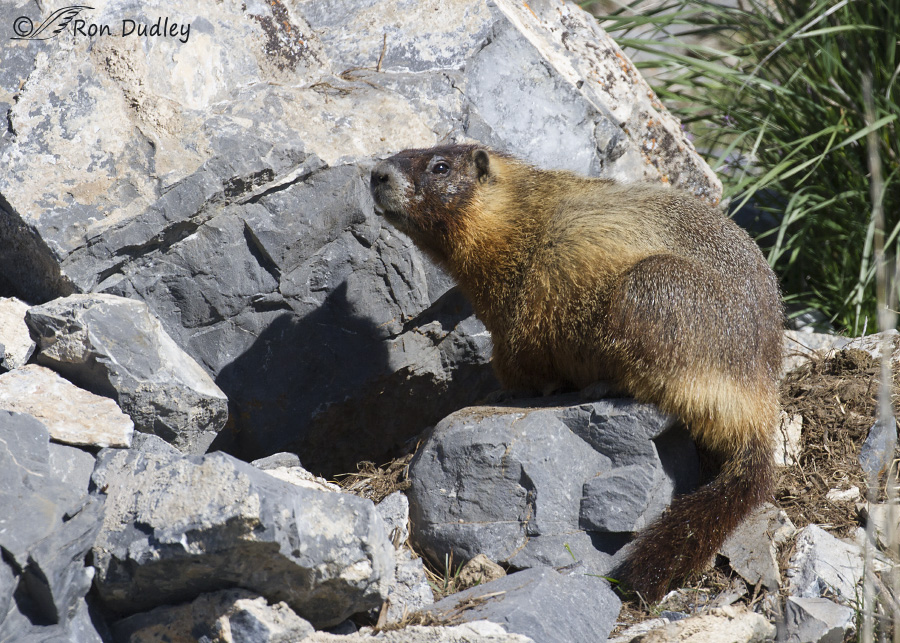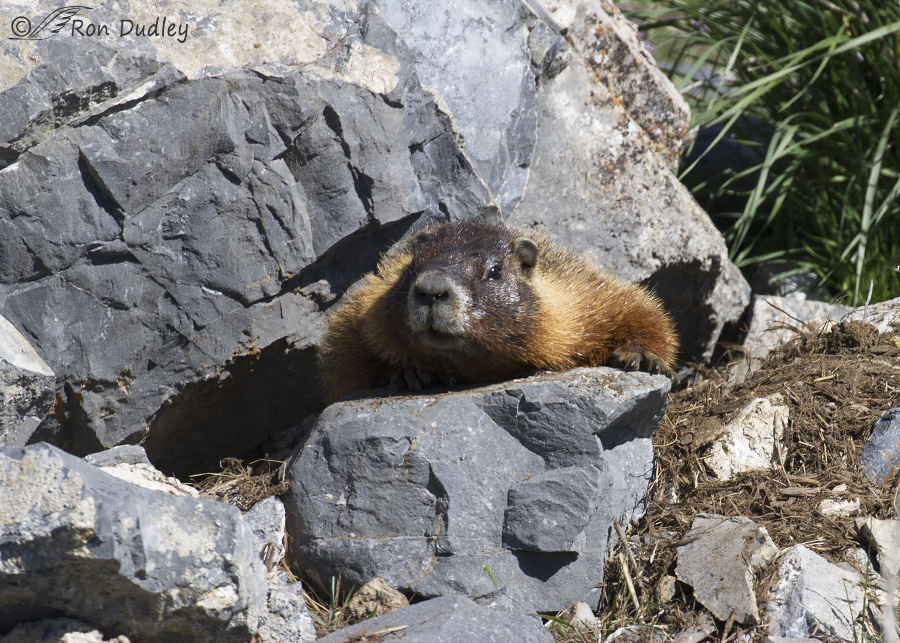A departure for me this morning, from feathers to fur.

1/1600, f/8, ISO 500, Canon 7D, Canon EF 100-400mm f/4.5-5.6L IS II USM, not baited, set up or called in
Typically I can’t get very close to Yellow-bellied Marmots but this one, photographed eleven days ago in a remote area of Box Elder County, was an exception. I think being so close to its den entrance (the cave-like hole at the bottom of the rock in front of the marmot) gave it a sense of security and some bravado.

1/2000, f/6.3, ISO 500, Canon 7D, Canon EF 100-400mm f/4.5-5.6L IS II USM, not baited, set up or called in
The marmot assumed this vertical posture for some time as it carefully checked me out (as usual I was inside my pickup).

1/2000, f/7.1, ISO 500, Canon 7D, Canon EF 100-400mm f/4.5-5.6L IS II USM, not baited, set up or called in
This is probably the best shot I got to show many of the physical features of this fairly common denizen of the mountainous areas of western North America.

1/1600, f/8, ISO 500, Canon 7D, Canon EF 100-400mm f/4.5-5.6L IS II USM, not baited, set up or called in
Once the marmot determined that I was no threat it relaxed and laid down on this large rock. It was really quite a cute pose because most of the time its chin was clear down on the rock but at this angle I couldn’t see the eyes well as it was doing so.
As a kid growing up in Montana I knew these marmots as rock chucks but they’re also called “whistle pigs” for their propensity to whistle as an alarm call when they see a predator.
Like chipmunks, groundhogs and prairie dogs, marmots are types of ground squirrels but they’re much larger than the typical ground squirrels that many of us are familiar with. For example, the Richardson’s Ground Squirrel that I grew up with in Montana weighs less than one pound but male Yellow-bellied Marmots can tip the scales at over 11 lbs.
That’s a pretty big rodent!
Ron
PS – Scientific American has posted an interesting and amusing clip of two marmots having an apparent disagreement about grazing rights to a particular area of grass. The sounds they make as they squabble (about half way through the clip) will probably make you smile. Here’s the link if you’re interested.


Oh no it looks like he saw his shadow.
I have absolute confidence in your ability to find one when the time comes!!!
I better not mess with weasels, Dick. Here’s what one of them did just today in Switzerland!
http://www.cnn.com/2016/04/29/tech/cern-weasel-irpt/index.html
Ah, but there is no particle accelerator in Utah or the Rockies or Montana that I know of!
I’m patient, I just know you will find another one, if not this summer maybe by winter when his coat turns. VBG, LOL!
Pesky little critters, aren’t they? YIKES!
Very cool! I was once sitting (hiding) at a campground in the Rockies. A weasel (I think…white with black feet and a black tipped tail) came right by me. I hide really well. 😀
It must have been a weasel in its winter coat, Arwen – though they’re all white except for their black nose, black eyes and black-tipped tail.
Ron, thanks for the side track
I’m glad you enjoyed the change of pace, David.
Nice images! It’s amazing that you got the marmot so close to its den/burrow. Could you tell if there were little ones inside? I have never seen a marmot in our part of MT.
Jane, I lived close to Glacier NP and would see them there but also in wooded and rocky ravines further away from the mountains.
No, I saw no indication of youngsters but they may still be very young and always in the den if they’re there.
Furry critters are good, too! I don’t think I’ve ever seen a yellow-bellied marmot before.
That name leads me into the concept of yellow-bellied as it applies to someone who is deemed to have no courage–a coward. Wonder how that association came into being?
Betcha that marmot has a little family in that den, it being that time of year and all, so you’re lucky your presence was accepted. It’s good not being a threat to a critter. If you had been a threat, and I’m correct in my assumption that there are little ones in that den, my guess is that marmot would NOT be a coward in defending her/his family!
What a coincidence, Laura! Just two days ago (my mind was wandering as I was driving) I wondered why we call so-called cowards “yellow”. I often think of it in the context of old western movies but you hear it elsewhere too.
I often wonder about the derivation of words/phrases–my mind just goes there, often without permission. 🙂 And like you, I remember that association in old westerns, but I suspect it goes way farther back than that.
I’ve often pondered the association of black with death and its implications with vultures, crows, black cats, black people, etc. That’s SO not fair, but there you have it.
I just did a little research on the “yellow” thing and found several theories about the origin but as far as I can tell none of them seem to be confirmed.
I wonder if the “yellow ” stigma thing has anything to do with urinating out of fear…so many creatures do it…just wondering…..
One explanation I saw was that the phrase began during the Mexican American War as a reference to the yellow on the uniforms of the Mexican soldiers. Have no idea of its validity.
I saw a wonderful program on owl on PBS last night…mainly about two hand-raised incubated Barn Owls. It was called OWL POWER. Just wondering if anyone else saw it and want to recommend it if it’s repeated….
I had a friend who had one of these critters make a nest in the engine compartment of their new suburban. It chewed up all of the wiring, dug the insulation out of car hood for nesting material, and did $800 dollars worth of repairs. One could probably also call them CAR CHUCKS! Their insurance wouldn’t cover it, they blamed it on being an act of nature, or some such thing.
Boy, that would have been aggravating, Marvin. But I’d probably have been at least as upset with the insurance company.
Marmots do look a lot like Woodchucks…the name “Rock Chuck” makes sense as they are so often seen around rocks, but wonder why “Woodchucks” are so named…I’ve seen plenty of them and their burrows, but always in an open area like a field or pasture, never in the woods….?
I don’t know, Patty. I’m mostly unfamiliar with woodchucks.
“Rock Chucks” really fits these guys…I’ve almost always seen them on a rock, in a pile of rocks ,or near rocks. They may have “Golden Bellies”, but I’ve never seen them…watched the link, listened to “squabbling(?), wondered why the one decided to travel so far to the exact same spot the second one was feeding in, then squabble (or were they) about it. Maybe more was going on than just grazing. Enjoyed these images! (Amazing how well a vehicle works as a blind…my car serves as one, too…can drive up close to one of our feeders without alerting or disturbing birds– until I open the door, then most of them take off…fast!
I nearly always see them on or near rocks too, Patty – except occasionally when I see one grazing on a large lawn. And you’re sure right about what happens to birds when you open your vehicle door!
Fantastic shots Ron!
Charlotte
Thanks, Charlotte.
Just wait until one of their urban cousins attempts to move under your house! Constant battle with groundhogs here in central Maryland. Marmots are cute, I guess.
“Marmots are cute, I guess”
Ha, you don’t sound convinced of that, George. I probably wouldn’t be either in your situation.
I’ve seen Marmots on Mount Rainier. There, they were cute.
Ah! “Rock Chucks” 🙂 Interesting critters – sounds like they’re bickering about something. Great pictures – glad you got off track! 🙂 Once watched an animal control officer chasing one that ended up in a car engine – yikes!
Ouch, I’ve seen the results when cats crawl up on a car engine. Not a pretty sight.
No, cats in car engines are NOT good! A common problem in this area in the winter when engine heaters are being used! 🙁
video clip
I think the sounds were like two kids, one found something fascinating and another tried to horn in on #1’s food!
Dick, the clip reminded me of the way some dogs react when they think you’re going to take away a bone or a toy that they like.
What a pleasant surprise, but I’m still watching for a few images of a weasel. VBG.
Great pictures as usual and the video was fun!
I love my pickup as a blind, it is so enjoyable watching your subject relax after figuring out you are not a threat.
Wonderful series, many thanks for sharing.
Don’t hold your breath on the weasel shots, Dick. I keep trying but they’re extremely elusive!